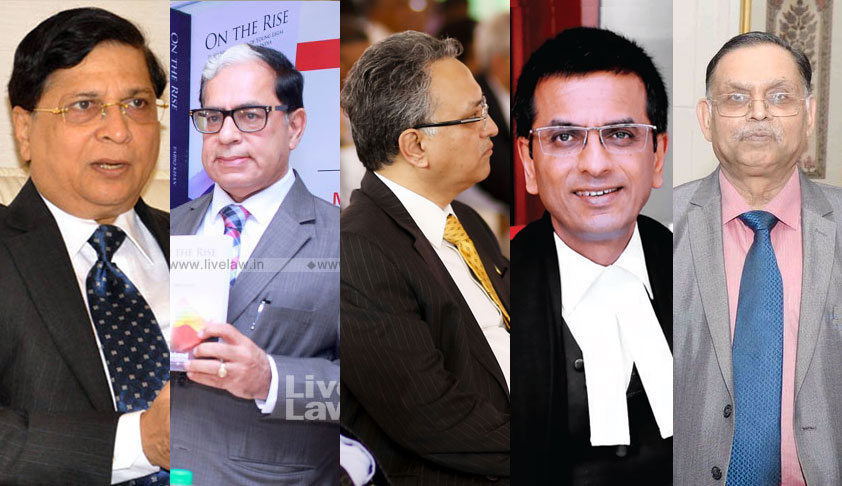- Home
- /
- Top Stories
- /
- In A First SC Allows Power Point...
In A First SC Allows Power Point Presentation During The Hearing: UIDAI To Present The PPT On Technicalities Of Aadhaar At 2.30pm
Mehal Jain
22 March 2018 9:19 AM GMT
On Day 21 of the Aadhaar final hearing, the Supreme Court five judge bench granted permission to the Centre to elaborate on the technical aspects of the Aadhaar project by way of a PowerPoint presentation by Dr. Ajay Bhushan Pandey, CEO, UIDAI, after having perusing the content thereof.On Wednesday, Justice D. Y. Chandrachud had indicated the concerns of data security, exclusion, manipulation...
On Day 21 of the Aadhaar final hearing, the Supreme Court five judge bench granted permission to the Centre to elaborate on the technical aspects of the Aadhaar project by way of a PowerPoint presentation by Dr. Ajay Bhushan Pandey, CEO, UIDAI, after having perusing the content thereof.
On Wednesday, Justice D. Y. Chandrachud had indicated the concerns of data security, exclusion, manipulation and surveillance as being the various technical aspects regarding the UIDAI and the Aadhaar scheme.
The PowerPoint presentation having been scheduled to take place at 2:30 PM on Thursday, The bench allowed the petitioners to compile the queries in the form of a questionnaire by Tuesday.
Thereupon, Attorney General K. K. Venugopal resumed his submissions in reference to the World Bank ‘Identifications for Development’ Integration Approach Study (ID4D), wherein the World Bank has investigated the various aspects of the Aadhaar project as well the identification regimes of other countries.
The Forward to the aforesaid report asserts, “Official Identification (ID) is more than a convenience; it is a fundamental human right. It is indispensable for connecting residents to electoral participation, educational opportunities, financial services, health and social welfare benefits, and economic development. It gives people a chance to better communicate with and be recognized by their government while giving governments the opportunity to listen and improve the lives of their citizens. Yet in the developing world, over 2 billion people lack an official ID. The problem disproportionately affects children and women, from poor rural areas in Africa and Asia...”
The AG drew the attention of the bench to the portions of the report linking identification with sustainable development and eradication of poverty. The report observes, “...(The ID4D) agenda has strong links to the World Bank Group’s twin goals of fighting extreme poverty and promoting shared prosperity. It is also aligned with the Sustainable Development Goals (SDGs) agenda- ‘provide legal identity to all, including birth registration, by 2030’...Proof of identity is critical for the poor to gain access to basic services, such as healthcare, social benefits and financial services. Similarly, identities are important for the bottom 40% of the population to have better access to job opportunities, services and finance. Yet hundreds of millions of children and adults worldwide do not have any form of recognized identification (ID)...”
The AG also discussed the issues of purpose limitation and strict necessity of the collection and use of sensitive personal data or information (SPDI) and protection thereof, as dealt with in the report.
In this context, the report describes the principle of ‘purpose limitation’ as the use by a data controller (government entity or private company) only for a specific purpose, predefined to the user, and that the Data may not be used, shared or stored for any reason beyond the specific purpose; and ‘data protection’ as the responsibility of The data controller for embedding the appropriate technology and taking adequate measures to prevent unauthorized persons from accessing the data or to prevent data from being accessed for unauthorized reasons. The report also envisages, for the purpose of data safety and protection, that The data controller inform system users that data is being collected from them (and subsequently used) and explain how long it will be used and who has access to it.
Submitting that an expenditure of Rs. 9,000 crores has been incurred by the government of India in the establishment and operation of the UIDAI, the AG quoted from the report in so far as it states that “...Integration of schemes’ subsidies as well as certain housing, education and health programs is one of the main sources of revenue for Aadhaar. According to a cost benefit analysis study done by the National Institute of Public Finance and Policy (NIPFP) in 2012, the investment on the Aadhaar project would provide a return of as high as 52.85% to the government...”
At this point, Justice Chandrachud inquired if the Enrolment and Authentication services are rendered free of cost under the Aadhaar project. The AG responded in the affirmative.
“With over 1.2 billion enrolments under the Aadhaar scheme, India is much ahead of other nations...the objective is to attain the goal of legal identity for each individual by 2030...”, Mr. Venugopal submitted.
Thereupon, the AG proceeded to discuss the chronology of the Aadhaar project from its inception in 2006, when several expert groups and Empowered Groups of Ministers had deliberated on its implementation, to the establishment of the UIDAI in 2009, to the passage of the Aadhaar (Targeted Deliveries of Financial and Other Subsidies, Benefits and Services) Act in 2016.
“Only the constitutionality of the Act is under challenge. Why are these dates relevant?”, inquired Justice A. K. Sikri.
Justice Chandrachud also asked why the statute was enacted seven years post the setting up of the UIDAI under a Planning Commission resolution.
In response, the AG submitted that the Aadhaar project is a well planned one and not one undertaken as a routine.


